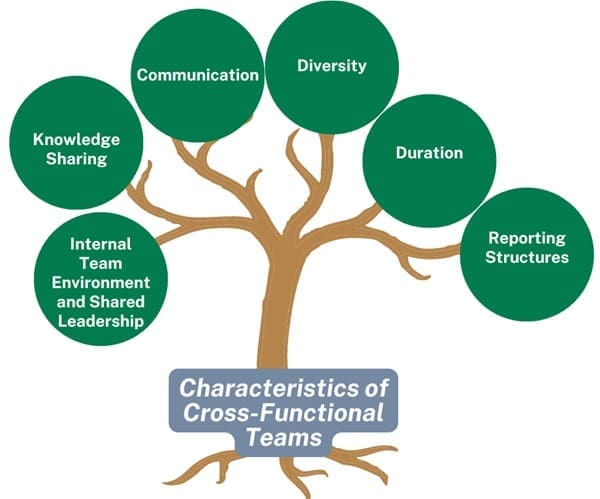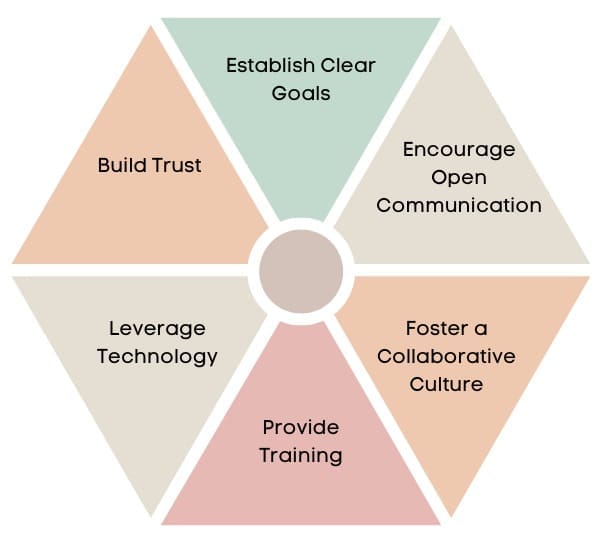A cross-functional team (CFT) is a group of individuals from different departments or areas within an organization who come together to achieve a shared objective. These teams often include members with varying expertise, such as marketing, finance, engineering, and operations, which enables them to tackle complex projects from multiple perspectives.
The emphasis on diverse skills and backgrounds fosters a collaborative environment, encouraging innovative solutions that might not arise in more homogeneous teams.
For instance, a motorcycle manufacturer like Harley-Davidson employs cross-functional teams to develop new models. These teams typically include a program manager from design, a manufacturing lead, a purchasing lead, and a marketing lead, all working in tandem to ensure the successful launch of a product.
Table of contents
- Definition of Cross-Functional Teams
- Strategies for Managing Cross-Functional Teams
- Role of Leadership in Cross-Functional Teams
- Communication in Cross-Functional Teams
- Importance of Interpersonal Relationships in Cross-Functional Teams
- Role of Shared History in Cross-Functional Teams
- Goals and Internal Coordination in Cross-Functional Teams
- Final Words
- Related Articles
Definition of Cross-Functional Teams
A cross-functional team (CFT) is a diverse group of individuals from various departments or areas of expertise who work collaboratively toward a shared organizational goal.
Holland et al. (2000) define a CFT as “a group of people who apply different skills, with a high degree of interdependence, to ensure the effective delivery of a common organizational objective.” To function effectively, a project manager needs to facilitate the dynamics within the team (Tonnquist, 2016).
Working with CFTs presents significant advantages, particularly regarding information exchange across diverse knowledge areas. This diversity is crucial for project success and innovation (Ghobadi & D’Ambra, 2012). The benefits of employing cross-functional teams can be categorized into several key aspects.
Benefits of Cross-Functional Teams

Cross-functional teams bring together varied skills and perspectives, fostering an environment conducive to creativity and problem-solving. According to Holland et al. (2000), the main benefits attributed to cross-functional teams include:
- Enhanced Creativity and Innovation: By pooling diverse expertise, teams can generate more innovative solutions and ideas.
- Improved Problem Solving: Diverse perspectives contribute to a comprehensive understanding of issues and more effective solutions.
- Increased Flexibility: Cross-functional teams can adapt more easily to changing project demands or organizational needs.
- Faster Decision-Making: With representation from multiple departments, decision-making can be quicker and more informed.
- Better Communication: Enhanced interaction among team members from different backgrounds fosters better communication and understanding.
- Higher Employee Engagement: Working in diverse teams can increase motivation and commitment among employees.
Characteristics of Cross-Functional Teams

Three main characteristics enhance the effectiveness of cross-functional teams:
- Internal Team Environment and Shared Leadership: This includes a positive team atmosphere, shared goals, and the distribution of leadership roles among members.
- Knowledge Sharing: Effective collaboration relies on the open exchange of information and skills among team members.
- Communication: Clear communication is essential for coordinating efforts and ensuring that everyone is aligned with the team’s objectives.
- Diversity: CFTs comprise individuals with varied expertise, which can enhance creativity but also create challenges related to trust and communication. Teams with greater diversity may initially experience lower levels of trust, but with time and effective management, this can improve.
- Duration: Teams can be temporary, formed for specific projects, or longer-lasting, allowing members to develop deeper relationships and better communication.
- Reporting Structures: Members may report to their functional managers while also being accountable to the cross-functional team, which can complicate decision-making processes and authority.
Importance of Cross-Functional Teams

Cross-functional teams play a vital role in enhancing communication across different departments, which ultimately leads to better customer service. By bridging gaps between various functional areas, these teams can align their goals with customer needs, ensuring that products and services meet market demands.
- Enhanced Problem-Solving: CFTs bring together diverse viewpoints, leading to more comprehensive analyses of problems and more effective solutions.
- Increased Efficiency: With members collaborating from different functions, tasks can be completed faster, as there’s less need for inter-departmental handoffs.
- Innovative Thinking: Diverse teams are more likely to generate creative ideas and approaches, as they leverage the unique insights and experiences of each member.
- Greater Accountability: Because team members share responsibility for outcomes, there is often a heightened sense of ownership and commitment to achieving project goals.
Challenges of Cross-Functional Teams

While CFTs offer many benefits, they also come with challenges that can hinder their effectiveness:
- Conflicting Goals: Team members often come from departments with their own priorities and objectives, which can lead to disagreements about project direction and resource allocation. For example, in a construction project, architects may focus on aesthetics, while engineers prioritize structural integrity, leading to potential conflicts.
- Difficulties in Trust Building: Trust is crucial in any team setting, but establishing it in cross-functional teams can be challenging due to differing backgrounds and objectives. When team members do not see each other as part of a cohesive unit, it can hinder collaboration.
- Communication Barriers: Different terminologies and jargon across departments can lead to misunderstandings, making effective communication a significant hurdle.
- Lack of Clarity in Roles: Members may struggle with their specific responsibilities within the team, leading to overlap or gaps in work.
- Time Management: Coordinating schedules among team members from various departments can lead to delays in decision-making and project progression.
- Misaligned Priorities: Each department has its own goals and key performance indicators (KPIs). If team members prioritize their departmental objectives over the collective team goal, it can hinder collaboration and progress.
Strategies for Managing Cross-Functional Teams

To maximize the effectiveness of cross-functional teams, organizations should implement certain strategies:
- Establish Clear Goals: Team members should understand the shared objective and how it aligns with their individual departmental goals. This can help to mitigate conflicts arising from differing priorities.
- Encourage Open Communication: Regular check-ins and open discussions can help to clarify roles, responsibilities, and project status, ensuring that everyone remains on the same page.
- Foster a Collaborative Culture: Leaders should create an environment that promotes teamwork and shared accountability. This can be achieved through team-building activities and recognition of collaborative efforts.
- Provide Training: Offering training sessions focused on teamwork, communication, and conflict resolution can equip team members with the skills necessary to navigate challenges effectively.
- Leverage Technology: Tools such as project management software and communication platforms can facilitate collaboration and streamline workflows.
- Build Trust: Encouraging personal interactions, sharing successes, and acknowledging contributions can help in building trust among team members.
Role of Leadership in Cross-Functional Teams
Effective leadership is essential for the success of cross-functional teams. Leaders should:
- Inspire a Shared Vision: Leaders must communicate the importance of the team’s objectives and how they contribute to the overall goals of the organization.
- Empower Team Members: Providing team members with the authority to make decisions can foster a sense of ownership and commitment to the team’s success.
- Support Collaboration: Leaders should encourage collaboration and provide the necessary resources to facilitate effective teamwork.
- Monitor Progress and Provide Feedback: Regularly checking in on team progress and offering constructive feedback can help identify issues early on and keep the project on track.
- Encourage Continuous Improvement: Leaders should promote a culture of learning, where team members can share insights and learn from both successes and failures.
Communication in Cross-Functional Teams
Communication is a cornerstone of effective teamwork in cross-functional teams. Early in a project, team members must agree on a clear, measurable target that everyone understands. In an agile environment, regular communication is essential for ensuring that the team remains aligned throughout the project (Tcgen, n.d.).
CFTs consist of members from various functions, each with different skill levels and backgrounds. This diversity can lead to knowledge differentiation, potentially creating communication barriers and conflicts. Effective communication is vital to overcoming these challenges and achieving high levels of team effectiveness (Cohen & Bailey, 1997).
Challenges in Communication
Despite the benefits, communication within cross-functional teams can present challenges:
- Communication Barriers: Differences in expertise levels among departments may lead to misunderstandings due to varying terminologies and communication styles.
- Misaligned Priorities: Each department has its own goals and key performance indicators (KPIs). If team members prioritize their departmental objectives over the collective team goal, it can hinder collaboration and progress.
- Lack of Connection: Team members may feel disconnected from one another due to their varied roles and backgrounds. This lack of connection can negatively affect teamwork and collaboration.
Importance of Interpersonal Relationships in Cross-Functional Teams
Good interpersonal relationships are vital for the motivation and discipline of cross-functional teams. Open communication helps prevent “groupthink,” where members may feel pressured to conform to the group’s ideas, sacrificing creativity and individual responsibility.
In interviews conducted with cross-functional team members, researchers found that team members valued their collaborative relationships. They felt comfortable sharing ideas and appreciated the supportive environment created by team leaders. This open exchange of ideas fosters innovation and engagement among members.
Despite these positive aspects, survey results indicate that there is still room for improvement in how decisions are made and how team members collaborate. Only half of the survey respondents felt that they participated in the decision-making process, suggesting that team dynamics could be enhanced further.
Role of Shared History in Cross-Functional Teams
Shared experiences may strengthen the relationships among cross-functional team members. Many respondents noted that their familiarity with one another from previous collaborations positively impacted their current teamwork. Respectful disagreement and open discussion were common, as team members recognized each other’s expertise and experience.
Goals and Internal Coordination in Cross-Functional Teams
For a cross-functional team to coordinate effectively, members must have a clear understanding of the team’s objectives, planned outcomes, and individual roles. Clear plans with measurable goals facilitate problem-solving and encourage cooperation among staff from different departments. This shared understanding increases motivation and commitment among team members.
CFTs often have broad goals, such as improving service delivery or enhancing organizational efficiency. However, without proper internal coordination, these teams may struggle to achieve their objectives. A well-defined strategy with clear expectations can significantly enhance a CFT’s effectiveness.
Final Words
Cross-functional teams are a powerful mechanism for driving innovation and efficiency within organizations. By harnessing the diverse skills and perspectives of team members from various functional areas, organizations can enhance their problem-solving capabilities and responsiveness to customer needs. However, the challenges inherent in cross-functional collaboration must be addressed through effective leadership, clear communication, and trust-building initiatives. With the right strategies in place, cross-functional teams can thrive, ultimately contributing to an organization’s success.
In summary, cross-functional teams serve as an essential tool for organizations aiming to be more customer-focused and competitive. They not only facilitate better communication across departments but also drive innovation and efficiency in achieving shared goals. By overcoming challenges and leveraging the strengths of diverse teams, organizations can create a more collaborative and dynamic work environment.


















